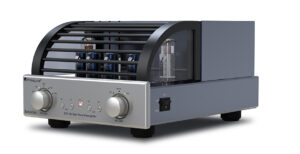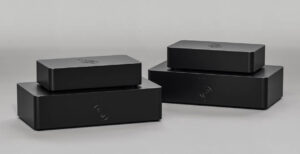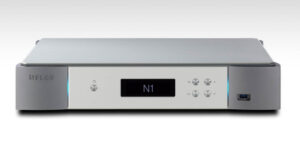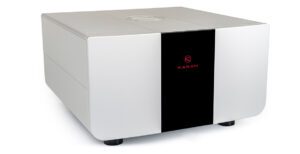
How many loudspeaker companies build all their own drive units and fit them into ground breaking cabinets? And how many of those companies are genuinely breaking new ground? By my calculation the answer is very few indeed, and of those Vivid Audio has the lowest profile. I mean you don’t need very many fingers to count the number of speaker companies that make their own tweeters and there are even fewer that go to the lengths that Vivid does when it comes to cabinet construction. The ‘box’ that the Giya G2 inhabits is made from two skins of reinforced glass fibre, which sandwich a core of end grain balsa. That is 12mm thick slices of balsa in 50mm square blocks and triangles individually laid up by hand. The result is a very curvy and distinctive cabinet on the outside that is both stiff and light and which has no sharp edges to cause diffraction. It’s genuinely leading edge stuff.
But what’s the deal with the Giya G2? It looks just like the G1 that came out in 2008 and appears to have the same drivers. Put the two side by side however and you will see that it’s a smaller version of the G1, with half the internal volume and 80% of its height. This is still a decent size loudspeaker that stands a metre and third tall but it’s easier to accommodate than a G1 because the bass drivers are 50mm smaller in diameter albeit using the same motor unit, and thus don’t go quite so low or so loud. This is not to say that they don’t have grip, grunt or girth.

Designer Laurence Dickie’s explanation for the G2’s unusually strong bass is that his work in pro audio for Turbosound has taught him that using oversized magnets on lightweight cones delivers this result. He compares it to the way that a large engine in a small car will give you more control, if it’s driven properly. The drive in this case being the crossover design. In Dickie’s B&W days (he was responsible for the original Nautilus) this approach was described as ‘over shoved’ – which doesn’t sound very positive – but in this instance it brings considerable benefits. The bass has many of the qualities you get with active loudspeakers, including impressive extension and power; some call it ‘grip’, others ‘slam’, but essentially it’s a combination of power and speed that is hard to achieve with passive designs.
It’s slightly at odds with the graceful design of the cabinet, but the G2 is a bit of a beast. Power handling is quoted as a whopping 800 watts and its delivery is so clean that I can easily believe it would be able to take this sort of energy without showing any sign of strain. I certainly encountered nothing of the sort at the levels I wicked them up to.

To get back to the G2’s make up, it’s a four-way, five driver system with all metal units and catenary domes on tweeter and midrange. I noted that the tweeter dome is reinforced with a carbon fibre ring which is something that Bowers used to do in its 800 series because if stiffens the driver sufficiently to add a very worthwhile increase in high frequency extension before break-up, in this case the figure quoted is 44kHz. Tweeter, mid and mid-bass units all have tapered tube loading and all the cones have maximum ventilation through the basket and even the coil former which relieves pressure behind the central dome. The two bass drivers are braced against one another in a reaction cancelling arrangement that doesn’t rely on stiffness in the enclosure, in fact the units are mounted on ‘O’ rings to minimise the transmission of energy (as are the rest of the drivers for that matter). The bass drivers also have a massive 50mm of mechanical travel, something that Dickie must have picked up on in his day-job.
Given that carbon fibre is all the rage these days I asked Dickie why Vivid hadn’t chosen this material instead of GRP for the cabinet skins. He agreed that CF is more of the moment and could look great but in practice its only real advantage would be a reduction in weight, which as this is not a car, would not enhance the potential sound quality of the speaker. The current vacuum infused GRP and balsa cabinet accounts for less than half of the finished speaker’s 55 kilo mass which is arguably light enough. There is some carbon fibre in the G2 however; it’s used to form the base, presumably because it can be moulded into more complex shapes with ease. The bi-wire cable terminals are right underneath the speaker which makes for a great looking rear end but a tricky cable swap if you’re on your own, I had to lay them on some cushions to do the job. There are six threaded inserts for custom made stainless steel spikes but their use is optional and I went with the ease of positioning that the smooth base confers. Vivid also supplies high quality terminal jumpers for those preferring to single wire.
The first thing that struck me about these speakers when I got them up and running was the character of the recording on the Grateful Dead’s Blues for Allah. Some speakers make the Audio Fidelity pressing of this album sound smooth and luxurious, perhaps a little bit more so than is likely to be the case with such a vintage record. The G2 reveals the warmth of the recording but also the unusual way in which the drums were laid down and the fact that this instrument is the key to the overall sound of this most jazzed out of Dead LPs. The record sounds much more of its age as well with lovely, chewy bass guitar notes and some top quality noodling from Garcia et al. A few more albums in, and it’s clear that the G2 is a very fast speaker. There is no sense of overhang or smearing of timing, yet unlike many examples of the breed, it is also devoid of forwardness. The speaker’s intrinsic character is totally clean which leaves acres of space for the qualities of the music to shine through.
When that music contains a emotional message you know all about it, in this case Laura Marling delivered the goods on her A Creature I Don’t Know album which is replete with fine detail yet strains at the compression on her voice when she raises it. Recording character both good and bad is obvious with the G2, yet this only reinforces the intensity of the performance so it’s been applied in an appropriate manner, enough so to provoke comments like “lummy and blimey jings, this is powerful stuff” from yours truly.
The speed applies across the band and does not require high power amplification to be enjoyed, I use Valvet A3.5 class A monoblocks and their 50 watts are enough to deliver bass lines that know how high when they are asked to jump. This was readily apparent with all sorts of music including the jazz blues of Conjure’s Music for the Texts of Ishmael Reed. This densely packed recording reveals the various layers involved in its creation as well as its analogue nature even though I was playing a 24/88.2 HDTracks file. Cleaner, fresher pieces like Samuel Yirga’s Habasha Sessions are even more real, in fact at low level this sounded truly magical, totally immersive, natural and effortless.
As you might expect from the aerodynamic shape of the enclosure imaging is a distinct strong point, Dickie suggested they be toed in so that the axis crossed in front of the listening seat which gave excellent stage width in my room but I preferred the tonal balance when sitting at the apex of the triangle with both speakers pointed straight at me. With a lot of speakers I find this set-up uncomfortable but the smooth, clean mid and treble on the G2 means that you can listen like this at any level you fancy and not encounter anything undesirable, unless its on the record of course. Something of this nature surprised me by turning up on ‘Keith Don’t Go’ the Nils Lofgren live track that is in danger of becoming a new Private Investigations on the demo front. This was presented as a totally coherent whole by the G2s; where many speakers deliver lots of scale but little image focus, this time it’s a man playing a guitar (with considerable skill) and both are in one spot in time and space. What you don’t usually hear is the limiting applied at the crescendo, at least not to the extent that the Vivids reveal, all commercial recordings are compressed to some extent but so are a lot of loudspeakers, that is not the case here.

This track also revealed the total lack of cabinet coloration from the G2, a quality that can be heard in the extra acoustic space available for notes to stop and start in – the fact that they end when they should being the key here. The other tell-tale sign is the noise floor being lower than it usually seems, cabinet contributions are a form of noise so when they are dramatically reduced you can hear quieter notes and more note decay and it’s rather addictive. So much so that the next pair of speakers I put on sounded positively crude despite their four and a half grand price tag, I appreciate that the price of that speaker is significantly less than that asked for the G2, but the difference was so great that it took several weeks to re-calibrate my expectations.
With music that has genuine dynamic range and depth of image such as Rachmaninov’s Symphonic Dances the power and scale of the orchestra is delivered in astonishing realism. This is where you really start to wonder how such low bass can be so well controlled. It gives the soundstage extraordinary depth and scale and the music real fear factor, I don’t think this piece was on an album called the Power of the Orchestra but it should have been.
Despite the phenomenal results I achieved with the G2s, I couldn’t help thinking that better amplification would have got more out of them. But try as I might I couldn’t get hold of anything truly suitable in the time available. I had my eye on the MSB S200 power amp that had made a brief visit a few months earlier, that has the power and finesse to do this speaker justice, I think. There were times when a bit more bite on leading edges would have helped particular tracks and a good class AB amp would likely provide that. I tried alternative cables and these enhanced certain qualities but this is such a revealing speaker that you can hear what’s missing rather easily.
Wyclef Jean’s ‘Thug Angels’ was one of the tracks that put me on the quest, its bass had far more subtlety than usual but not quite as much slam, something 200 clean watts would undoubtedly deliver. But with this track you are talking about a studio composite, a sound that has no real absolute. With a string quartet recorded with an eye to fidelity the result was as good as I have ever got. The instruments sounded totally real and provoked the realisation that the G2 has the finesse of an electrostatic combined with the power and dynamics of a boxed speaker. Very rarely can cones and domes deliver the softness of real strings complete with the acoustic of the studio so effectively, and even less common is one that can go from soft to loud and back again in such immediate and effortless fashion.

A lot is made of the wonders of 3D televisions, but even the best deliver a pretty poor facsimile of the real thing. With a speaker like this you are far closer to experiencing a solid presence in the room and you don’t even need special glasses!
I got a superb result with the Vivid Giya G2, a better one it seemed than that with the G1 a couple of years ago. Although I put this down to mostly better ancillaries in the system and the advent of computer audio, but it’s also likely that the slightly smaller size of the loudspeaker system suited the realistically sized room better. Suffice it to say that both are world class loudspeakers that should be considered by anyone looking for the very best that a sound system can deliver.
Technical Specifications
Type: 4-way, 5-driver floorstanding loudspeaker system
Cabinet: Glass reinforced balsa cored sandwich composite, carbon fibre base
Driver Complement:
- HF driver: 26mm metal dome, tapered tube loading, catenary profile
- Mid driver, 50mm metal dome, tapered tube loading, catenary profile
- Mid/bass driver: 125mm with tapered tube loading, short-coil long-gap motor design, 50mm copper ribbon coil
- Bass drivers: 2 x 175mm metal coned unit with short-coil long-gap motor design, 75mm copper ribbon coils
Bass loading: Exponentially tapered tube enhanced bass reflex
Sensitivity: 89dB
Impedance (Ohms): 6 nominal, 4 minimum, low reactance
Crossover frequencies: 220, 880, 3500 Hz
Power handling (music programme): 800 watts rms
Dimensions (H, W, D): 1383, 360, 638mm
Net weight: 55kg
Standard finishes: black, pearl white
Price: £34,500 per pair
Manufactured by:
Vivid Audio
Tel.: Tel: +44(0)1403 78 2221
URL: www.vividaudio.com
Tags: FEATURED
By Jason Kennedy
More articles from this authorRead Next From Review
See all
PrimaLuna EVO 100 phono preamplifier
- Apr 22, 2024

Reiki Audio SuperSwitch Master Pro + Servant Pro
- Mar 27, 2024

Melco Audio N1-S38 music server
- Mar 27, 2024











